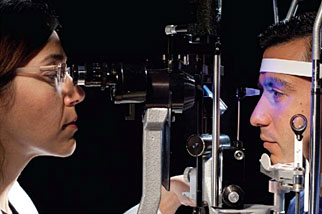1. More than 2.7 million Americans over age 40 have glaucoma. That number is estimated to more than double by 2050. Though glaucoma is the second leading cause of blindness in developed countries, increased awareness and ongoing research may reduce the health burden of glaucoma.
2. Anyone can develop glaucoma. Though it’s more common in people over the age of 45, babies and children can get a rare form of early onset glaucoma. The following groups are at higher risk of glaucoma:
- African Americans over age 40
- People over age 60, especially Mexican Americans
- People with a family history of glaucoma
Caption: This video shows how open angle glaucoma progresses and affects vision.
4. Don’t wait for symptoms. Lack of awareness and lack of symptoms prevent people from getting glaucoma diagnosed early, notes Jullia Rosdahl, M.D., Ph.D., of the National Eye Health Education Program and Duke Eye Center. Without treatment, people with glaucoma will slowly lose their peripheral (side) vision. Over time, central (straight-ahead) vision is also affected.

Caption: Sight without side vision may seem like looking through a tunnel.
5. Glaucoma damages the eye’s optic nerve. The optic nerve is like a data cable coming out of the back of your eye. It carries visual information to your brain. Glaucoma damages the nerve cells or “wires” in the cable, disrupting the flow of visual information.
Caption: The optic nerve (highlighted) travels from eye to brain.
6. Once glaucoma damages your optic nerve, lost vision cannot be restored. Early detection combined with treatment can slow or stop glaucoma progression.

Caption: In cross-section, the optic nerve and retina funnel (left to right) information to the brain. The optic nerve (the purple stem of the funnel) collects information from the retina (the mouth of the funnel). Credit: Drs. Alejandra Bosco and Monica L. Vetter, University of Utah.
7. Eye pressure is a major risk factor for glaucoma. However, not every person with increased eye pressure will develop glaucoma, and glaucoma can develop without increased eye pressure.

Caption: A tonometer measures pressure inside the eye and helps detect glaucoma.
8. The only clinically proven treatment for glaucoma is to lower eye pressure. Some medicines cause the eye to make less fluid. Others lower pressure by helping fluid drain from the eye.

Caption: Regularly use of medicated eye drops is a common treatment for glaucoma.
9. A new drug-delivery system is currently being tested. NEI-funded researchers are testing a drug-dispensing contact lens (link is external) that may be easier to use than drops or pills.

Caption: Joseph B. Ciolino, M.D., is an ophthalmologist at Massachusetts Eye and Ear Infirmary and an Assistant Professor of Ophthalmology at Harvard Medical School. Credit: Mass. Eye and Ear/Peter Mallen
10. Studies in the laboratory and with patients are making key discoveries and giving new hope.
- Researchers at NEI are studying how to protect retinal ganglion cells, the cells that make up the optic nerve.
- NEI-funded researchers at Indiana University-Purdue University Indianapolis turned patient-derived stem cells (link is external) into retinal ganglion cells.
- Recent NEI-funded analysis identified three additional genes that contribute to the most common type of glaucoma.
- Scientists at the Medical College of Georgia at Augusta University found that high expression of a short (link is external) gene may contribute to destructive eye pressures in glaucoma.
- NEI-funded researchers at the Icahn School of Medicine at Mount Sinai developed a method to test potential glaucoma treatments (link is external) and study disease progression.
###
NEI leads the federal government’s research on the visual system and eye diseases. NEI supports basic and clinical science programs to develop sight-saving treatments and address special needs of people with vision loss. For more information, visit https://www.nei.nih.gov.
About the National Institutes of Health (NIH): NIH, the nation’s medical research agency, includes 27 Institutes and Centers and is a component of the U.S. Department of Health and Human Services. NIH is the primary federal agency conducting and supporting basic, clinical, and translational medical research, and is investigating the causes, treatments, and cures for both common and rare diseases. For more information about NIH and its programs, visit http://www.nih.gov/ (link is external).
NIH…Turning Discovery Into Health®